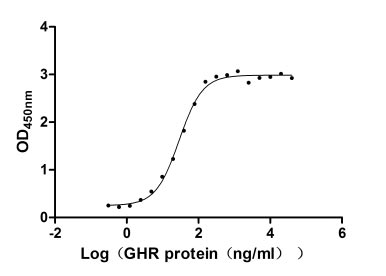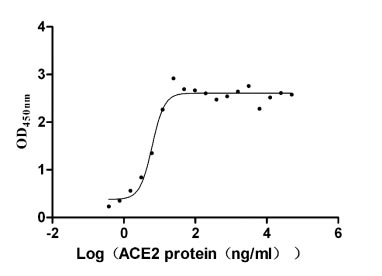Recombinant Human Ubiquitin D (UBD)
-
中文名称:人UBD重组蛋白
-
货号:CSB-YP025435HU
-
规格:
-
来源:Yeast
-
其他:
-
中文名称:人UBD重组蛋白
-
货号:CSB-EP025435HU-B
-
规格:
-
来源:E.coli
-
共轭:Avi-tag Biotinylated
E. coli biotin ligase (BirA) is highly specific in covalently attaching biotin to the 15 amino acid AviTag peptide. This recombinant protein was biotinylated in vivo by AviTag-BirA technology, which method is BriA catalyzes amide linkage between the biotin and the specific lysine of the AviTag.
-
其他:
-
中文名称:人UBD重组蛋白
-
货号:CSB-BP025435HU
-
规格:
-
来源:Baculovirus
-
其他:
-
中文名称:人UBD重组蛋白
-
货号:CSB-MP025435HU
-
规格:
-
来源:Mammalian cell
-
其他:
产品详情
-
纯度:>85% (SDS-PAGE)
-
基因名:UBD
-
Uniprot No.:
-
别名:Diubiquitin; FAT10; GABBR1; UBD 3; Ubd; UBD_HUMAN; Ubiquitin D; Ubiquitin like protein FAT10; Ubiquitin-like protein FAT10
-
种属:Homo sapiens (Human)
-
蛋白长度:Full length protein
-
表达区域:1-165
-
氨基酸序列MAPNASCLCV HVRSEEWDLM TFDANPYDSV KKIKEHVRSK TKVPVQDQVL LLGSKILKPR RSLSSYGIDK EKTIHLTLKV VKPSDEELPL FLVESGDEAK RHLLQVRRSS SVAQVKAMIE TKTGIIPETQ IVTCNGKRLE DGKMMADYGI RKGNLLFLAC YCIGG
-
蛋白标签:Tag type will be determined during the manufacturing process.
The tag type will be determined during production process. If you have specified tag type, please tell us and we will develop the specified tag preferentially. -
产品提供形式:Lyophilized powder
Note: We will preferentially ship the format that we have in stock, however, if you have any special requirement for the format, please remark your requirement when placing the order, we will prepare according to your demand. -
复溶:We recommend that this vial be briefly centrifuged prior to opening to bring the contents to the bottom. Please reconstitute protein in deionized sterile water to a concentration of 0.1-1.0 mg/mL.We recommend to add 5-50% of glycerol (final concentration) and aliquot for long-term storage at -20℃/-80℃. Our default final concentration of glycerol is 50%. Customers could use it as reference.
-
储存条件:Store at -20°C/-80°C upon receipt, aliquoting is necessary for mutiple use. Avoid repeated freeze-thaw cycles.
-
保质期:The shelf life is related to many factors, storage state, buffer ingredients, storage temperature and the stability of the protein itself.
Generally, the shelf life of liquid form is 6 months at -20°C/-80°C. The shelf life of lyophilized form is 12 months at -20°C/-80°C. -
货期:Delivery time may differ from different purchasing way or location, please kindly consult your local distributors for specific delivery time.Note: All of our proteins are default shipped with normal blue ice packs, if you request to ship with dry ice, please communicate with us in advance and extra fees will be charged.
-
注意事项:Repeated freezing and thawing is not recommended. Store working aliquots at 4°C for up to one week.
-
Datasheet :Please contact us to get it.
相关产品
靶点详情
-
功能:Ubiquitin-like protein modifier which can be covalently attached to target protein and subsequently leads to their degradation by the 26S proteasome, in a NUB1-dependent manner. Probably functions as a survival factor. Conjugation ability activated by UBA6. Promotes the expression of the proteasome subunit beta type-9 (PSMB9/LMP2). Regulates TNF-alpha-induced and LPS-mediated activation of the central mediator of innate immunity NF-kappa-B by promoting TNF-alpha-mediated proteasomal degradation of ubiquitinated-I-kappa-B-alpha. Required for TNF-alpha-induced p65 nuclear translocation in renal tubular epithelial cells (RTECs). May be involved in dendritic cell (DC) maturation, the process by which immature dendritic cells differentiate into fully competent antigen-presenting cells that initiate T-cell responses. Mediates mitotic non-disjunction and chromosome instability, in long-term in vitro culture and cancers, by abbreviating mitotic phase and impairing the kinetochore localization of MAD2L1 during the prometaphase stage of the cell cycle. May be involved in the formation of aggresomes when proteasome is saturated or impaired. Mediates apoptosis in a caspase-dependent manner, especially in renal epithelium and tubular cells during renal diseases such as polycystic kidney disease and Human immunodeficiency virus (HIV)-associated nephropathy (HIVAN).
-
基因功能参考文献:
- the intrinsic instability of FAT10 together with its disordered N-terminus enables the rapid, joint degradation of FAT10 and its substrates. PMID: 30127417
- Overexpression of FAT10 promotes cisplatinresistant bladder cancer formation. These results indicated FAT10 may be a novel target for the treatment of bladder cancer. PMID: 29749526
- the results of the present study suggest that FAT10 may be involved in DDR and therefore the progression of tumorigenesis. PMID: 29620277
- Up-Regulation of UBD Transcript is associated with focal segmental glomerulosclerosis. PMID: 29531077
- FAT10 promotes tumor proliferation by directly stabilizing Survivin protein in breast cancer cells. PMID: 27806337
- our data suggest that FAT10 was upregulated via retinoic acid-induced protein I and NF-kappaB during H5N1 avian influenza virus infection. And the upregulated FAT10 promoted H5N1 viral replication by inhibiting type I IFN. PMID: 27354218
- we show how FAT10 stabilizes the translation elongation factor eEF1A1, which contributes to cancer cell proliferation PMID: 27312528
- this study revealed a novel function of LMO2 involving in the regulatory hierarchy of UBA6-USE1-FAT10ylation pathway by targeting the E1 enzyme UBA6. PMID: 27569286
- unlike ISG15, ubiquitin and FAT10 are conjugated to a similar degree to newly translated and pre-existing proteins. PMID: 27926780
- We also found that FAT10 may act its oncogenic functions through regulating HOXB9. Collectively, the results suggested that FAT10 may be a novel therapeutic target for osteosarcoma patients PMID: 27279480
- High expression of FAT10 is associated with glioma. PMID: 26733179
- Study demonstrates how the coordinated interplay of RIG-I, TRIM25, and FAT10 regulate the antiviral innate inflammatory response. PMID: 26996158
- Data suggest that ubiquitin D (UBD) provides a negative feedback on cytokine-induced activation of the endoplasmic reticulum to nucleus signaling 1 (IRE1alpha)/c-Jun N-terminal kinase (JNK) pro-apoptotic pathway in cytokine-exposed beta cells. PMID: 27044747
- FAT10 can induce malignant transformation as evidenced from the anchorage-independent growth as well as in vivo tumor-forming abilities of FAT10-overexpressing NeHepLxHT cells. PMID: 24325913
- repertoire of peptides eluted from MHC class I molecules was influenced by FAT10 expression PMID: 26401002
- FAT10 is the only ubiquitin-like modifier known to date which directly targets its hundreds of substrates for degradation by the proteasome. (Review) PMID: 25983082
- Conjugation of the ubiquitin activating enzyme UBE1 with the ubiquitin-like modifier FAT10 targets it for proteasomal degradation PMID: 25768649
- the interaction of FAT10 with MAD2 is a key mechanism underlying the promalignant property of FAT10 PMID: 25422469
- Results identified a novel HCC regulatory circuit involving FAT10, beta-catenin/TCF4, and HOXB9, the dysfunction of which drives invasive and metastatic character in HCC. PMID: 25056121
- STAT3 and NFkappaB synergistically act for maximum induction of FAT10 expression. PMID: 24518302
- transcription downregulation of the Ufm1 and FAT10 conjugation system in liver Mallory-Denk bodies formation PMID: 24893112
- functional distribution of the FAT10 targets suggests that FAT10 participates in various biological processes, such as translation, protein folding, RNA processing, and macromolecular complex assembly PMID: 23862649
- FAT10 expression in pancreatic ductal adenocarcinoma (PDAC) was an independent prognostic factor of patients, which might be a potential diagnostic and therapeutic target of PDAC PMID: 24492942
- These results suggest that knockdown of FAT10 by adenovirus-delivered siRNA may be a promising therapeutical strategy for treatment of hepatocellular carcinoma. PMID: 24440736
- FAT10 has a central role in regulating diverse aspects of the pathogenesis of hepatocellular carcinoma. PMID: 23812429
- FAT10 protects cardiac myocytes against apoptosis. PMID: 23416168
- Immunohistochemistry showed that FAT10 protein was over-expressed in glioma tissues. Expression level of FAT10 increase from grade I to grade IV glioma according to the results of real-time PCR, immunohistochemistry analysis and Western blot. PMID: 22402871
- p62 becomes covalently mono-FAT10ylated at several lysines, and FAT10 colocalizes with p62 in p62 bodies. PMID: 22797925
- FATylation of LRRFIP2 occurs on two distinct sites, each being modified by a single FAT10 moiety. PMID: 23036196
- These data reveal that VHS domain of Stam2 enters the hydrophobic pocket of K48-linked diubiquitin and binds the two ubiquitin subunits with different affinities. PMID: 21121635
- This study identified eEF1A1 as a FAT10-specific binding protein, and when the expression of FAT10 was reduced by siRNA knockdown, this resulted in downregulation of eEF1A1 expression in hepatoma cells. PMID: 22569823
- FAT10 modification of the HCMV-derived antigen pp65 (FAT10-pp65) enhances the presentation of the HLA-A2-restricted pp65495-509 antigenic peptide and provide evidence that FAT10- pp65 differs from Ub-modified pp65 in using the proteasome machinery. PMID: 22349260
- Ten SNPs in FAT10 were identified. PMID: 22292662
- Data indicate the potential role of cytokine-induced FAT10 expression in regulating Uba6 pathways. PMID: 22427669
- findings show how FAT10 and NUB1L dock with the 26S proteasome to initiate proteolysis; identified the 26S proteasome subunit hRpn10/S5a as the receptor for FAT10, whereas NUB1L can bind to both Rpn10 and Rpn1/S2. PMID: 22434192
- implicate FAT10 in retinal cell biology and Leber congenital amaurosis pathogenesis, and reveal a new role of AIPL1 in regulating the FAT10 pathway. PMID: 22347407
- In this study a crystal structure of linear diubiquitin at a resolution of 2.2 A degrees is reported. PMID: 22281738
- Degradation of FAT10 is accelerated after induction of apoptosis, suggesting that it plays a role in prosurvival pathways PMID: 22072791
- FAT10 plays an important role in mediating the function of TNF-alpha during tumorigenesis by inducing cell cycle deregulation and chromosomal instability. PMID: 22025632
- An extract of bark from the tropical rainforest plant Byrsonima crassifolia was screened for inhibition of diubiquitin formation by the human ubiquitin-conjugating enzyme E2-25K. PMID: 22164771
- Data indicate that the 20,000-bp region is telomeric of the UBD gene and contains LOC729653, a hypothetical gene. PMID: 21631897
- new role for FAT10 in the pathogenesis of polyglutamine diseases. PMID: 21757738
- The p53 transcriptional activity was found to be substantially enhanced in FAT10-overexpressing cells. PMID: 21396347
- USE1 is not only the first E2 enzyme but also the first known substrate of FAT10 conjugation, as it was efficiently auto-FAT10ylated in cis but not in trans. PMID: 20975683
- Genetic polymorphism in UBD is associated with colorectal cancer. PMID: 21351261
- Reverse transcriptase-polymerase chain reaction analysis of intestinal biopsy sample pairs (at diagnosis vs treated) from 30 celiac disease patients confirmed overexpression of UBD in active disease tissue. PMID: 19808075
- FAT10 may modulate tumorigenesis through its reported interaction with the MAD2 spindle-assembly checkpoint protein. PMID: 12730673
- FAT10 is degraded by the proteasome in ubiqitin-independent manner. PMID: 15831455
- high levels of FAT10 protein in cells lead to increased mitotic nondisjunction and chromosome instability, which is mediated by an abbreviated mitotic phase and reduction in the kinetochore localization of MAD2 during prometaphase PMID: 16495226
- Immunohistochemical studies demonstrated increased FAT10 expression in HIV-associated nephropathy and in autosomal dominant polycystic kidney disease. PMID: 16495380
显示更多
收起更多
-
亚细胞定位:Nucleus. Cytoplasm. Note=Accumulates in aggresomes under proteasome inhibition conditions.
-
组织特异性:Constitutively expressed in mature dendritic cells and B-cells. Mostly expressed in the reticuloendothelial system (e.g. thymus, spleen), the gastrointestinal system, kidney, lung and prostate gland.
-
数据库链接:
HGNC: 18795
OMIM: 606050
KEGG: hsa:10537
STRING: 9606.ENSP00000366249
UniGene: Hs.44532
Most popular with customers
-
Recombinant Human Growth hormone receptor (GHR), partial (Active)
Express system: Mammalian cell
Species: Homo sapiens (Human)
-
Recombinant Paguma larvata Angiotensin-converting enzyme 2 (ACE2), partial (Active)
Express system: Mammalian cell
Species: Paguma larvata (Masked palm civet)
-
Recombinant Human IGF-like family receptor 1 (IGFLR1), partial (Active)
Express system: Mammalian cell
Species: Homo sapiens (Human)
-
Recombinant Human Transferrin receptor protein 1 (TFRC), partial (Active)
Express system: Mammalian cell
Species: Homo sapiens (Human)
-
Recombinant Human Cadherin-6(CDH6),partial (Active)
Express system: Mammalian cell
Species: Homo sapiens (Human)

















